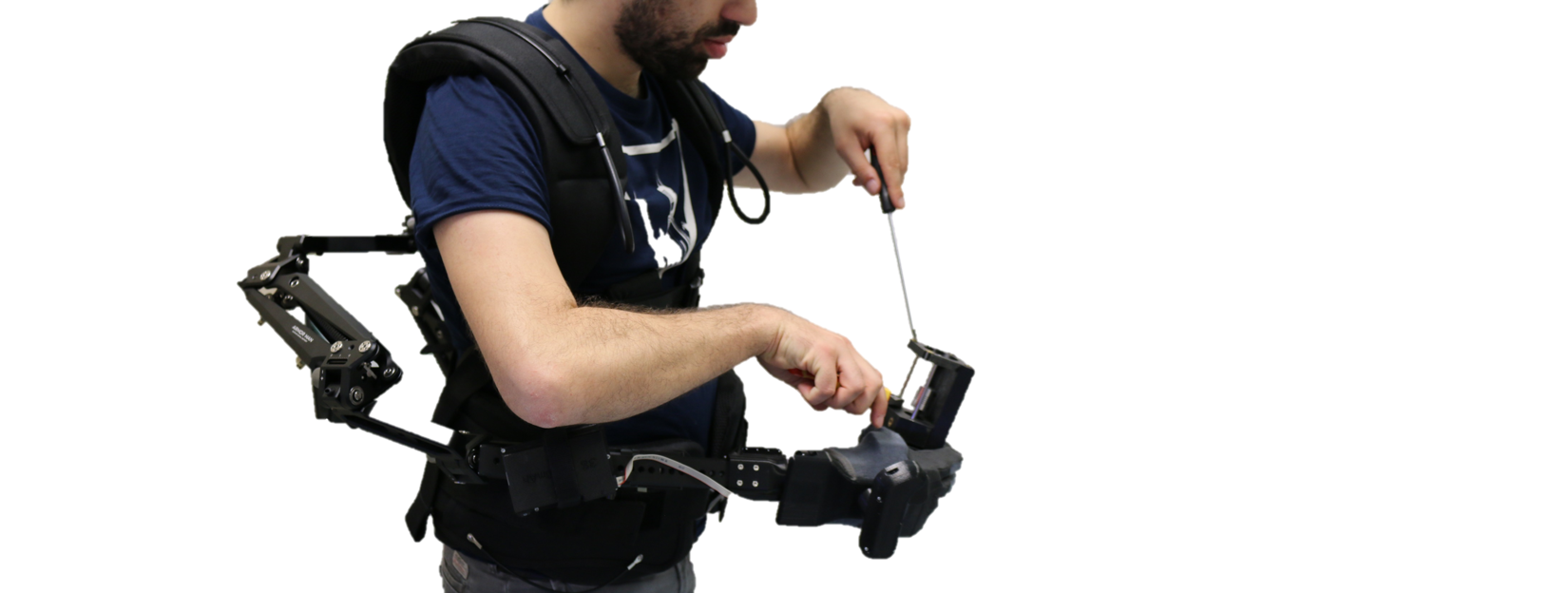Assistive Robotics/Power Augmentation

Assistive wearable robotic devices are commonly used for human body power augmentation or rehabilitation. Such mechanisms could prove indispensable in addressing problems of injuries and growing elderly population. As the devce is attached to the human body, it is imperative that appropriate control methods and human-robot interfaces are developed to enable coordinated motion and assistance in the complex daily tasks. The main objective in this research line is the development of appropriate control strategies to facilitate the interaction between the human, the power augmentation/assistive device and the environment.
Interfaces for Dynamic Control of Assistive/Power Augmentation Devices
The research activity in this area will explore the use of bio-signals such as EMG and EEG for control of the prosthetic/power augmentation devices. In this direction, a shared level of autonomy between the user intention and device controller will be implemented that will potentially result in a desired interaction performance. In addition, HRI2 aim at developing novel power augmentation devices, therefore, we highly encourage applications for hardware developments as well.
- A. Ajoudani, S.B. Godfrey, M. Catalano, M. Bianchi, G. Grioli, N. Tsagarakis and A. Bicchi, "Exploring Teleimpedance and Tactile Feedback for Intuitive Control of the Pisa-IIT SoftHand", IEEE Transactions on Haptics, Special Issue on Haptics in Rehabilitation and Neural Engineering, 7(2):203-15, 2014.
- N. Karavas, A. Ajoudani, N. Tsagarakis, J. Saglia, A. Bicchi and D. Caldwell, "Tele-Impedance based Assistive Control for a Compliant Knee Exoskeleton: Stiffness Augmentation and Motion Assistance", Robotics and Autonomous Systems, 2014.
Soft Brain-Machine Interfaces (Soft BMI)
This line of research aims at exploring the potential of a novel soft Brain-Machine Interface (BMI), suitable for a wide range of operators, for dynamic execution of remote tasks. The interface is composed of an eye-tracking system, for an intuitive and reliable control of a robotic hand-arm system's trajectories, and a brain-computer interface unit, for the estimation of the desired task accuracy (and force) which is associated to the robot Cartesian stiffness. The latter is achieved by the estimation of a unidimensional concentration index in real-time and replicated by the robot's impedance controller. An example video of the setup is available to provide solid evidence on the effective execution of tasks with dynamic uncertainties, highlighting the potential of the proposed approach in applications such as self- service and clinical care.
- L. Schiatti, J. Tessadori, G. Barresi, L. S. Mattos, and A. Ajoudani, "Soft Brain-Machine Interfaces for Assistive Robotics: A Novel Control Approach", International Conference on Rehabilitation Robotics (ICORR), 2017.
An Active Supernumerary Hand for Grasping Assistance
This line of reserach presents a novel supernumerary hand system, i.e. the SoftHand X, that aims to augment the grasping capabilities. The system consists of an active soft robotic hand and a passive gravity compensation mechanism. The extra limb can help restore the missing functionalities of patients to perform ADL, or provide healthy users with augmented capabilities, e.g. for manipulating hazardous objects.
- A. Ciullo, F. Felici, M. Catalano, G. Grioli, A. Ajoudani, and A. Bicchi "Toward an Active Supernumerary Hand for Grasping Assistance: Analytical and Experimental Analysis for Performance Optimization", IEEE Robotics and Automation Letters (RA-L), 2018.
